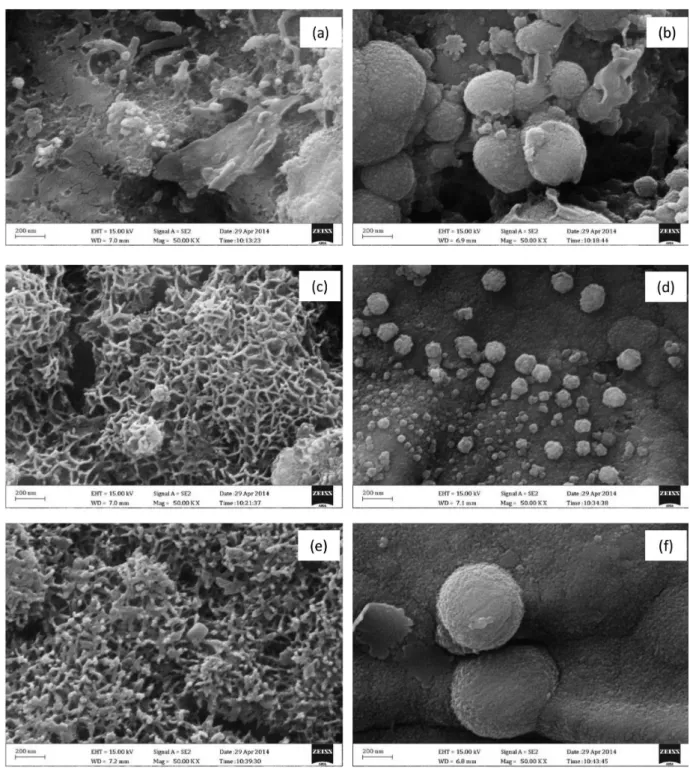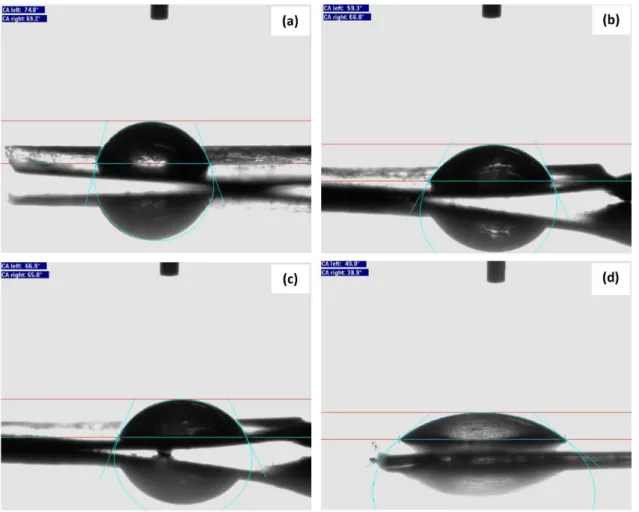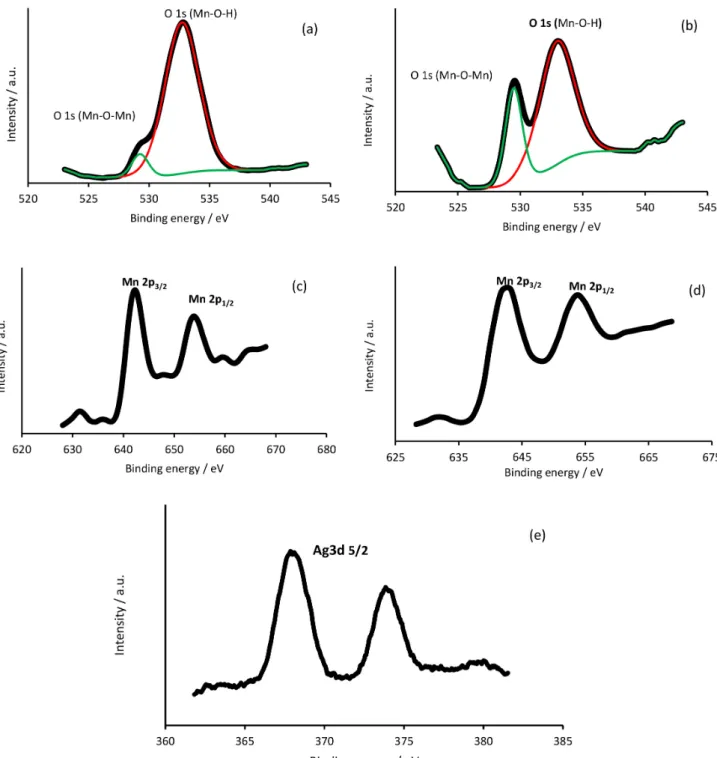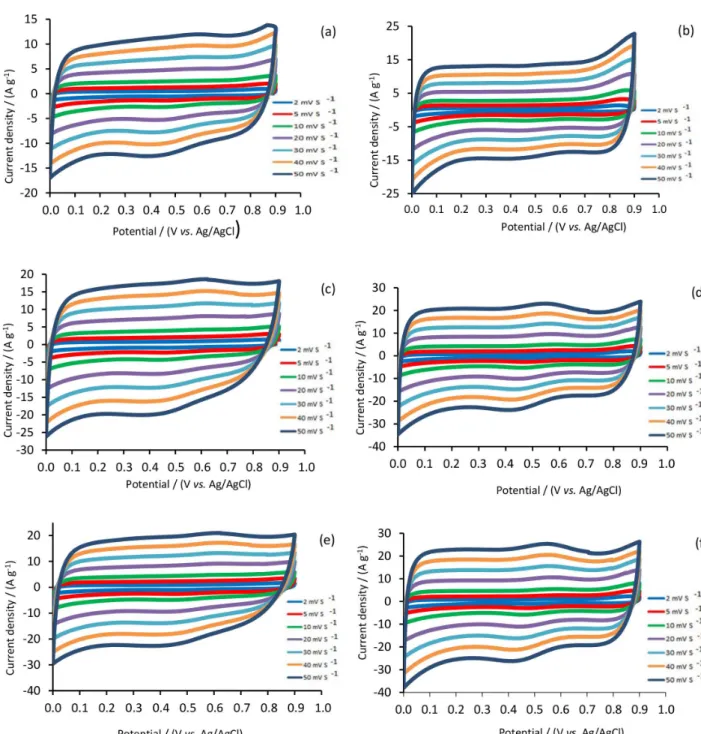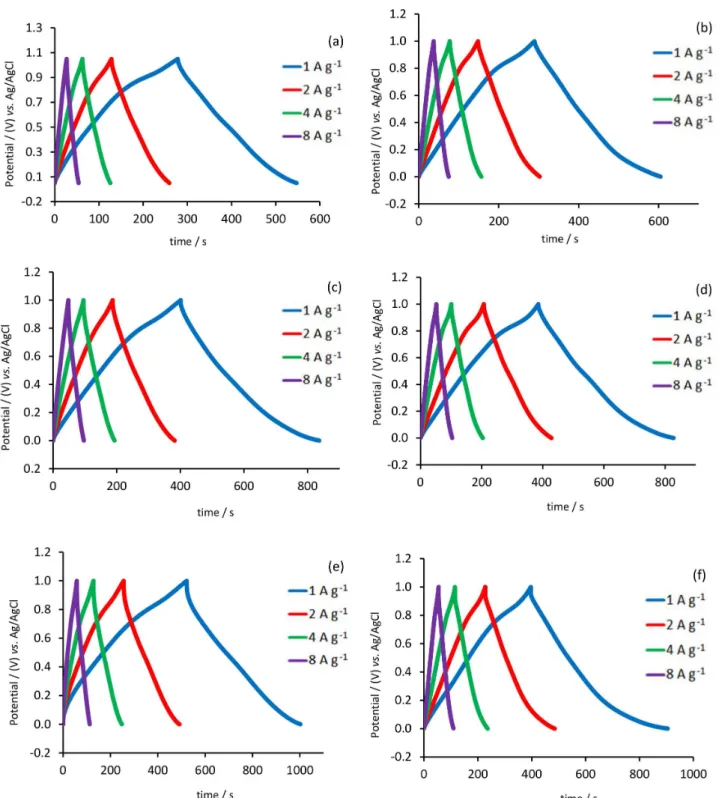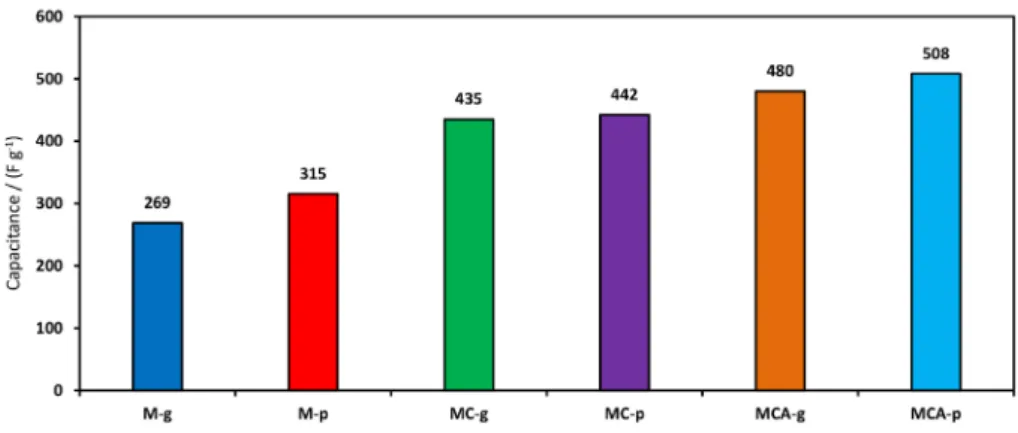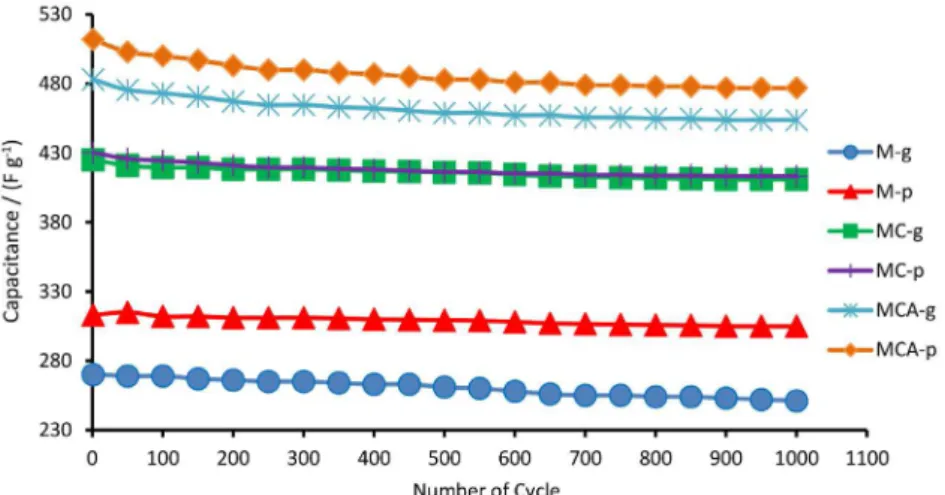Article
Printed in Brazil - ©2017 Sociedade Brasileira de Química0103 - 5053 $6.00+0.00
*e-mail: kalhor1363.h@gmail.com
A Comparative Study on Ag-Doped and Surfactant Assisted MnO
2Prepared by
Direct and Pulse Current Electrodeposition on Surgical Grade Stainless Steel as
High-Performance Supercapacitor
Mohammad Faridi,a Alireza Nari,a,b Hamideh Kalhor*,c and
Mohammad H. Dadjoob,d
aDepartment of Chemistry, Amirkabir University of Technology (Tehran Polytechnic), Tehran, Iran
bResearch and Development Center, Atlas Energy Co. Atlas Tajhiz Mandegar Corporation, Tehran, Iran
cDepartment of Chemistry, Faculty of Sciences, Tarbiat Modares University, Tehran, Iran
dDepartment of Chemical Engineering, Amirkabir University of Technology (Tehran Polytechnic), Tehran, Iran
Direct and pulse current electrodeposition techniques were applied for preparation of novel electro-active manganese oxides. The influences of Ag doping and addition of cetyltrimethylammonium bromide (CTAB) on electrochemical properties were discussed. The morphology and structure of the electrodes are studied by different techniques including field emission scanning electron microscopy (FE-SEM), contact angle and X-ray photoelectron spectroscopy (XPS). Electrochemical behavior of the samples are investigated by cyclic voltammetry (CV), constant current charge-discharge (CC), and electrochemical impedance spectroscopy (EIS). The specific capacitances were measured to be 269, 315, 435, 442, 480 and 508 F g-1 for M-g, M-p, MC-g, MC-p, MCA-g and MCA-p (current density = 1 A g-1), respectively.
The MCA-p exhibit high specific capacitance, excellent cycling stability (only 7.5% loss after 1000 cycles at 1 A g-1), and high energy densities (71 Wh kg-1). Ag doping and addition of CTAB
which provides more active sites for the pseudocapacitive reactions.
Keywords: supercapacitor, MnO2, CTAB, Ag doping, pulsed current
Introduction
Research on electrochemical capacitors (ECs) has generated growing attention from both academia and industry in recent years, with efforts focused on developing safe, stable, high energy/power density, and low cost materials.1 ECs are considered a promising power storage
device for backup power storage, peak power sources and hybrid electric and fuel cell vehicles. Based on the intrinsic principles of charge storage and discharge in ECs, the energy stored is either capacitive (non-faradaic) or pseudocapacitive (faradaic) in nature. The non-faradaic process relies on charge separation at the interface between the electrode and the ionic solution giving rise to an electrical double layer, whereas the faradaic process consists of redox reactions occurring within the active electrode materials.2-4
Transition metal oxides have been appropriate active materials for ECs. Various transition metal oxides, such as RuO2,5,6 Co3O4,7 NiO,8,9 Fe2O3,10 SnO2,11 MnO2,12-15
and etc., are being considered for the supercapacitor applications with their charge storage mechanisms based on pseudocapacitance. In recent years, manganese dioxide (MnO2) can be used as an active electrode materials in
ECs. The capacitance of MnO2 electrode is believed
to be predominant due to pseudocapacitance, which is attributed to reversible redox transitions involving exchange of protons and/or cations with the electrolyte.16
The methods used for the fabrication of manganese oxide electrodes are mostly based on the deposition of thin films or pasting manganese oxide powders mixed with binders and conductive additives on conductive current collectors.
potentiodynamic,19 and pulse deposition.20 For having
uniform deposition it is necessary to have constant current density during deposition. In addition, pulse deposition as one of essential techniques has been useful to synthesize different thin films. It can improve chemical-physical properties of active materials.21,22 For a manganese oxide
supercapacitor, the oxide film can be deposited on many substrates, which act as current collectors. Along with graphite,23 nickel24 and other conductive materials,25
stainless steel can be used because it is inert in various supercapacitor electrolytes. Among the various grades of stainless steel, Surgical Grade Stainless Steel (316L) are particularly attractive because of nonmagnetic properties as well as good strength and corrosion resistance in such electrolytes as KOH, Na2SO4 solutions and others.
The electrochemical performance of supercapacitors were improved by adding a surfactant agent.26-29 The
researchers prepared polythiophenes (PTs) by chemical oxidative polymerization in presence and absence of three different surfactants (cationic-cetyltrimethylammonium bromide (CTAB), anionic-sodium dodecyl sulfate (SDS) and non-ionic-Triton X-100) using FeCl3 as oxidant. The
PT prepared with Triton X-100 exhibited higher specific capacitance of 117 F g-1compared to 78 F g-1 of surfactant
free PT by the cyclic voltammetry test.30 Wu and Wang31
prepared nickel oxide film with open macropores by anodic deposition in the presence of surfactant CTAB and it shows a very high capacitance of 1110 F g-1 at
scan rate of 10 mV s-1. The influencing mechanism of the
surfactant concentrations has not been fully understood.31
It is important Ag-doping in supercapacitor fabrication. Ag-doped RuO2 showed much higher specific capacitance
compared to undoped RuO2.32 Huang et al.33 prepared the
array of CuO nanosheet and it is doped by Ag via the silver mirror reaction. The specific capacitance of the Ag-doped CuO nanosheet electrode is 689 F g-1, much higher than
that of the unmodified CuO nanosheet arrays (418 F g-1).
In this work, the manganese oxide films were electrodeposited by the direct galvanostatic and pulse current methods from potassium permanganate electrolyte, respectively. In addition, we doped Ag into electrode based on MnO2 to improve charge transfer resistance. A
surface-active molecule with a polar group were also used for preparation of supercapacitor electrodes. Thus, MnO2 was
electrodeposited in presence of CTAB and AgNO3 with
both pulse current and direct galvanostatic methods. The characteristics of MnO2 active materials were investigated
by field emission scanning electron microscope (FE-SEM), X-ray photoelectron spectroscopy (XPS), contact angle, constant current charge-discharge (CC), electrochemical impedance spectroscopy (EIS) and cyclic voltammetry (CV).
Experimental
P o t a s s i u m p e r m a n g a n a t e ( K M n O4) ,
silver nitrate (AgNO3) and cetyltrimethylammonium
bromide (CTAB) were applied for electrodeposition. All of materials were purchased from the Merck Company (Germany). All solutions were prepared using deionized water and stainless steel (316 grade) 1 mm thickness electrodes used as substrate.
A 1 cm2 stainless steel slice was taken as anode
electrode. At first, it was burnished with rough sand paper. Then, it was etched for 5 min in 0.5 mol L-1 NaOH aqueous
solution by ultrasonic bath. After that it was rinsed with ethanol and deionized water, respectively.
The direct and pulse current electrodeposition were performed in a two-electrode system using the stainless steel substrate as a working electrode and a platinum counter electrode from 10 mol L-1 KMnO
4 containing
0 and 2 mol L-1 AgNO
3 at ambient temperature. The direct
galvanostatic electrodeposition has carried out at current density of 2 mA cm-2 for 60 seconds and pulse current
deposition performed at the same current density for 240 deposition cycles with on-time of 0.25 s and off-time of 0.5 s. The CTAB in concentration 1 mol L-1 was added to
predetermined solutions to investigate surface morphology of samples and its effects on electrochemical behavior of electrodes. Stainless steel electrodes was weighed after electrodeposition and subtract of primary mass of electrode before electrodeposition to obtain mass of active materials. Table 1 shows composition of manganese oxide base of electrodes.
X-ray photoelectron spectroscopy (XPS) has been measured with a Kratos XSAM 800 ultrahigh vacuum photoelectron spectrometer using the Mg Kα line as the
excitation source. The microstructure and morphology of MnO2 were investigated by means of field-emission
scanning electron microscopy (Carl ZEISS-SIGMA VP, Germany). Surface wettability was evaluated by water angle contact measurement, using a commercial contact angle meter (Dataphysics OCA15plus, Germany). The water drops (1 mL, ultra-pure) put onto the film surface using vertical syringe.
The electrochemical techniques such as CV, CC and EIS were used to study the capacitance of the modified working electrodes. Platinum grid (1 cm2) and saturated
Ag/AgCl were used as counter and reference electrodes, respectively. In these techniques a solution of 1 mol L-1
sodium sulfate (Na2SO4) was used as supporting electrolyte.
First of all, CV-grams were carried out in the range of 0.0 to 0.9 V at various scan rate (2-50 mV s-1). The
of the samples in different current densities (1-8 A g-1)
were studied. Furthermore EIS measurements have been carried out at frequency range of 10 kHz to 10 mHz. All of the electrochemical tests were performed by using a ZIVE SP1 potentiostat/galvanostat/FRA workstation (WonATech, Korea).
Specific capacitance (CS) in F g-1 were calculated
through galvanostatic charge-discharge measurements using the following equation:
(1)
where I is the discharge current density in A g-1, ∆t is
the discharge duration in s, and ∆V is the potential range in V. Energy density (ED) in Wh kg-1 derived from
the galvanostatic discharge curves using the following equation:
(2)
where CS is the specific capacitance in F g-1 and ∆V is the
potential range in V.
Results and Discussion
Morphological and structural characterization
Figure 1 presents FE-SEM images of samples, which show very different morphology. The formation of oxygen-containing intermediate MnIII species (e.g., MnOOH,
[Mn(H2O)6]3+, and Mn2O3) and the growth of passive
layers on the anode surface were the main reasons for the difference in the morphology of samples. In pulse current deposition, during toff, dissolution and/or removal of the
passive intermediate species took place on the anode surface. Therefore, new and/or fresh sites were created after each off-time, and grain growth prevailed at the next on-time. In other words, the nucleation rate decreased, so the formation of larger grains was possible.34 Consequently, as seen in
Figures 1b, 1d and 1f, pulse current deposited MnO2 are
relatively compact and well covered with spherical grains of uniform size. The results reveal that pulse current deposition causes the morphology of MnO2 to be more ordinary and more
compact (Figures 1b, 1d and 1f). Furthermore, micrographs clearly illustrate that the Ag addition significantly affect the appearance of the oxide electrodes. In the presence of CTAB, agglomerated oxide nanoparticles with a foam-like structure were observed (Figure 1a). In contrast, without structure-directing surfactants, denser film structures were observed (Figures 1c-f). Surfactants significantly affect the morphology of the MnO2 films. They play an important role in the
nucleation and growth of hybrid films through the hemisphere-micelle formation at the electrode-liquid interface.35
Morphological results presented in Figure 2 are further studied by performing contact angle measurement. Contact angle of 0° means complete wetting, and contact angle of 180° corresponds to complete non-wetting. The contact angles were found to be 72, 63, 66 and 39° for MC-g, MC-p, MCA-g and MCA-p, respectively. Contact angle of MC-p and MCA-p is clearly lower than that of MC-g and MCA-g indicating better wettability of pulse method synthesized electrodes. These results recognized that MC-p and MCA-p had more hydrophilic groups. In addition, these results show that with Ag doping the contact angle decreases and finally film surface becomes more hydrophilic. Generally, low water contact angle increases the electrochemical performance, where interfacial contact at electrolyte-electrode is important.36
XPS test provides a sensitive measurement of a chemical state in near surface region of material. To obtain information on surface chemical states of the working electrodes, XPS analysis was performed (Figure 3). In Figures 3a and 3b, the spectrums have been smoothed using 9-point Savitzky-Golay filtering.37 The O1s peak region
can be deconvoluted into two components: (i) Mn−O−Mn with binding energy (BE) ca. 529 eV; and (ii) Mn−O−H with BE ca. 533 eV (Figures 3a and 3b). The Mn2p spectra of these samples are quite similar and all exhibit multiple
Table 1. Composition of manganese oxide based of electrodes
Abbreviation [KMnO4] / (mol L-1) [CTAB] / (mol L-1) [AgNO
3] / (mol L-1) Method of electrodeposition
M-g 10 − −
galvanostatic
MC-g 10 1 −
MCA-g 10 1 2
M-p 10 − −
pulse current
MC-p 10 1 −
MCA-p 10 1 2
Figure 1. FE-SEM images of (a) M-g; (b) M-p; (c) MC-g; (d) MC-p; (e) MCA-g; (f) MCA-p.
splitting with two main peaks located at 642.2 and 664.0 eV, which can be assigned to Mn2p3/2 and Mn2p1/2 of Mn4+ in
MnO2, respectively (Figures 3c and 3d). Binding energy of
Ag3d5/2 peak is near 367.9 eV for MCS-p, suggesting that
silver element exists as the form of Ag+ ions (Figure 3e)
that indicating to AgMnO2.38 The Mn2p spectra of
AgMnO2 was individually divided by curve fitting to obtain
the ionic state information of the element and to estimate the relative proportion of the different ionic states.39 As a
result, the content of MnIII is higher than the others and
the negative charge is more on MCA-p. Therefore, more Ag+ ions can be absorbed and more Ag nanoparticles are
doped on MCA-p.
Electrochemical characterization
MnO2 electrodes were subjected to CV in 0.5 mol L-1
Na2SO4 and they were found to exhibit capacitance
behavior. Figure 4 shows the CV curves of the MnO2 films
and mirror-image characteristics of the CV curves reveal the ideal pseudocapacitive behavior of all electrodes. The main information of Figures 5a-f is stated as follows: (i) the films prepared with pulsed current method have higher capacitances than that of the films electrodeposited by galvanostatic direct, due to their morphologies that lead to better diffusion of electrolyte ions; (ii) the electrochemical capacitance of MnO2 can be improved in the presence
of CTAB and AgNO3; (iii) the MCA-p film have the
largest area of cyclic voltammograms in higher scan rate (50 mV s-1), which means that this film has the best
high power rate capacitance; (iv) the films were prepared with pulsed current method have the best ideally cyclic voltammograms from higher to lower scan rate, indicating that these films have best charge and discharge efficiency.40
Specific capacitances of all MnO2 based films at different
scan rates are calculated (Supplementary Information section, Table S1). The specific capacitances were measured to be 264, 319, 425, 462, 465 and 516 F g-1 at 2 mV s-1 for
M-g, M-p, MC-g, MC-p, MCA-g and MCA-p, respectively. These data indicate that the CS increase by doping of Ag
into MnO2 based electrodes for both methods of synthesis.
This can be explained from, improved conductivity of
electrodes by introducing the Ag in MCA-g and MCA-p samples, which provide facilitated electron transfer. The CS was slowly decreased with increasing the scan rate.
As regards, proton transfer process is slow, higher scan rate leads to saturation of the protons in the electrolyte/ electrode interface during the redox process. This mainly results that increase of ionic resistivity leading to drop in the capacitance of the electrodes.
Galvanostatic charge-discharge cycling between 0 and 1 V of samples in 0.5 mol L-1 Na
2SO4 and different current
densities (1-8 A g-1) were shown in Figure 5. All curves
exhibited an almost equilateral triangle shape indicating the good efficiency of the charge-discharge process. There is a linear relation between potential and time during charging and discharging processes, which is another reason for capacitance behavior of a material in addition to exhibiting rectangular voltammograms. The IR drop (cell potential drop) is attributed to the internal resistance of the electrode associated with electrical connection resistance, bulk solution resistance, and resistance of ion migration in electrode materials. It can be seen that the IR drop in the films prepared with pulsed current melthod is obviously lower than others (Figures 5b, 5d, 5f). It can be seen that
MCA-g and MCA-p have the highest capacitance among all the examined electrodes and shows good rate capability (Figures 5e and 5f). Specific capacitance was decreased with increasing the current density (Figure 6). Better capacitance behavior and lower IR drop in the MCA-g and MCA-p samples may be attributed to the fact that the presence of CTAB and Ag can provide a conductivity for the MnO2 in electron transfer process. Herein, the MCA-g and
MCA-p shows higher and better capacitance behavior than
the sample in which MnO2 was the electrode. The CC was
investigated galvanostatically at various current densities (1-8 A g-1). C
S and ED of all electrodes at current density
of 1 A g-1 are summarized in Table 2. Specific capacitances
were measured to be 269, 315, 435, 442, 480 and 508 F g-1
at current density of 1 A g-1 for M-g, M-p, MC-g, MC-p,
MCA-g and MCA-p, respectively.
For more investigating, alternating current (AC) impedance measurements were performed (Figure 7). It
should be noted that Nyquist plot of an ideal supercapacitor is comprised of a vertical line, while appearing a semicircle at high frequency region is indicative of interfacial charge transfer resistance. It demonstrates a semicircle in high-frequency and a linear curve in the low-high-frequency region. The semicircle in the high-frequency region is related to reaction kinetics at the electrode and electrolyte interfaces. Linear curve at the low-frequency region can be attributed to diffusion controlled process in the electrolyte. Based on Nyquist plots (Figure 7), faradic charge transfer resistance (Rct) of M-g, M-p, MC-g, MC-p, MCA-g and
MCA-p obtained were 52.75, 26.06, 32.4, 13.1, 17.1 and 6.28 Ω cm-2, respectively. These results show faster charge
transfer rate for films that were electrodeposited by pulsed current. As it can be seen, the Ag doped electrodes have got significantly lower charge-transfer resistance values in comparison with other samples which is attributed to the improved electrical conductivity in these samples, due to contribution of highly-conductive Ag components. Rct
decreases after modification with Ag and CTAB. Slope of linear section in high frequency in MCA-p becomes close to nearly vertical line, which indicate a nearly pure
capacitive behavior. The near vertical line proves that electrostatic charge-discharge process for MCA-p in Na2SO4 is strongly fast.
The stability of the MnO2 based electrodes were also
investigated by continuous charge-discharge measurements over 1000 cycles at a current density 1 A g-1, as shown
in Figure 8. As can be seen, the capacitance for MCA-p
gradually decreases to 433 F g-1 after 1000 cycles
corresponding to a capacitance loss of 7.5%. Based on the cycling performance (Figure 8), the capacitance loss of M-g, M-p, MC-g, MC-p, MCA-g and MCA-p obtained is 6.6, 2.3, 2.4, 7.5, 7.5 and 7.5%, respectively. These observations demonstrate cycling performance of MnO2
based electrodes.
Figure 5. Galvanostatic charge-discharge curves of (a) M-g; (b) M-p; (c) MC-g; (d) MC-p; (e) MCA-g; (f) MCA-p at various current density (1-8 A g-1)
Table 2. Values of specific capacitance and energy density at current density of 1 A g-1 for all samples
Sample Specific capacitance / (F g-1)
Energy density / (Wh kg-1)
M-g 269 37
MC-g 435 60
MCA-g 480 67
M-p 315 44
MC-p 442 61
MCA-p 508 71
Figure 6. The charge-discharge specific capacitance of the samples at a 1 and 8 A g-1.
Conclusions
MnO2-based electrodes in presence Ag and CTAB
were successfully synthesized by galvanostatic and pulse deposition techniques, and applied as supercapacitor electrode active material. Surface morphology of the MnO2 electrode is more compact when we used pulse
deposition techniques. The MCA-p electrode exhibited good electrochemical performance including high specific capacitance (508 F g-1 at 1 A g-1), high energy density and
Figure 8. Cycling performance of the MnO2 electrodes at a current density 1 A g-1.
excellent cycling stability. This good electrochemical performance related to surface morphology, CTAB addition and Ag doping. Moreover, Ag doped electrodes have significantly lower charge-transfer resistance values in comparison with other electrodes which have attributed to developed electrical conductivity.
Supplementary Information
Supplementary information (the specific capacitances of all MnO2 based films at different scan rates calculated)
is available free of charge at http://jbcs.sbq.org.br as PDF file.
Acknowledgments
This work has been supported by grants and technical advices from Tarbiat Modares University Research Council. The financial supports by Atlas Energy Corporation (Affiliated Atlas Tajhiz Mandegar Co.) research and development center and Fundamental Research Funds for the Atlas Energy Co. are gratefully acknowledged.
References
1. Winter, M.; Brodd, R. J.; Chem. Rev. 2004, 104, 4245. 2. Sharma, P.; Bhatti, T.; Energy Convers. Manage. 2010, 51, 2901. 3. Zhi, M.; Xiang, C.; Li, J.; Li, M.; Wu, N.; Nanoscale 2013, 5,
72.
4. Anwar, A. W.; Majeed, A.; Iqbal, N.; Ullah, W.; Shuaib, A.; Ilyas, U.; Bibi, F.; Rafique, H. M.; J. Mater. Sci. Technol. 2015,
31, 699.
5. Devadas, A.; Baranton, S.; Napporn, T. W.; Coutanceau, C.;
J. Power Sources 2011, 196, 4044.
6. Mondal, S. K.; Munichandraiah, N.; J. Power Sources 2008,
175, 657.
7. Zhi, J.; Deng, S.; Zhang, Y.; Wang, Y.; Hu, A.; J. Mater. Chem. A 2013, 1, 3171.
8. Yeager, M. P.; Su, D.; Marinković, N. S.; Teng, X.;
J. Electrochem. Soc. 2012, 159, A1598.
9. Moosavifard, S. E.; Shamsi, J.; Fani, S.; Kadkhodazade, S.;
RSC Adv. 2014, 4, 52555.
10. Xie, K.; Li, J.; Lai, Y.; Lu, W.; Zhang, Z. A.; Liu, Y.; Zhou, L.; Huang, H.; Electrochem. Commun. 2011, 13, 657.
11. Selvan, R. K.; Perelshtein, I.; Perkas, N.; Gedanken, A.; J. Phys. Chem. C 2008, 112, 1825.
12. Huang, H.; Wang, X.; Nanoscale 2011, 3, 3185.
13. Yu, G.; Hu, L.; Liu, N.; Wang, H.; Vosgueritchian, M.; Yang, Y.; Cui, Y.; Bao, Z.; Nano Lett. 2011, 11, 4438.
14. Duay, J.; Sherrill, S. A.; Gui, Z.; Gillette, E.; Lee, S. B.; ACS Nano 2013, 7, 1200.
15. Ma, W.; Chen, S.; Yang, S.; Chen, W.; Cheng, Y.; Guo, Y.; Peng, S.; Ramakrishna, S.; Zhu, M.; J. Power Sources 2016, 306, 481. 16. Wan, C.; Cheng, M.; Zhang, Q.; Jia, N.; Powder Technol. 2013,
235, 706.
17. Dubal, D.; Kim, W.; Lokhande, C.; J. Phys. Chem. Solids 2012,
73, 18.
18. Gupta, V.; Gupta, S.; Miura, N.; J. Power Sources 2008, 175, 680.
19. Prasad, K. R.; Miura, N.; J. Power Sources 2004, 135, 354. 20. Fang, Y.; Liu, J.; Yu, D. J.; Wicksted, J. P.; Kalkan, K.; Topal,
C. O.; Flanders, B. N.; Wu, J.; Li, J.; J. Power Sources 2010,
195, 674.
21. Sharma, R.; Rastogi, A.; Desu, S.; Electrochem. Commun. 2008,
10, 268.
22. Davies, A.; Audette, P.; Farrow, B.; Hassan, F.; Chen, Z.; Choi, J.-Y.; Yu, A.; J. Phys. Chem. C 2011, 115, 17612.
23. Hu, C. C.; Tsou, T. W.; Electrochim. Acta 2002, 47, 3523. 24. Chang, J. K.; Tsai, W. T.; Chen, P. Y.; Huang, C. H.; Yeh, F. H.;
Sun, I. W.; Electrochem. Solid-State Lett.2007, 10, A9. 25. Shinomiya, T.; Gupta, V.; Miura, N.; Electrochim. Acta 2006,
26. Zhao, T.; Jiang, H.; Ma, J.; J. Power Sources 2011, 196, 860. 27. Subramania, A.; Devi, S. L.; Polym. Adv. Technol. 2008, 19,
725.
28. Zhang, K.; Mao, L.; Zhang, L. L.; Chan, H. S. O.; Zhao, X. S.; Wu, J.; J. Mater. Chem. 2011, 21, 7302.
29. Mao, L.; Zhang, K.; Chan, H. S. O.; Wu, J.; J. Mater. Chem.
2012, 22, 80.
30. Senthilkumar, B.; Thenamirtham, P.; Selvan, R. K.; Appl. Surf. Sci. 2011, 257, 9063.
31. Wu, M.-S.; Wang, M.-J.; Chem. Commun. 2010, 46, 6968. 32. Ahn, H.-J.; Sung, Y.-E.; Kim, W. B.; Seong, T.-Y.; Electrochem.
Solid-State Lett. 2008, 11, A112.
33. Huang, J.; Wu, H.; Cao, D.; Wang, G.; Electrochim. Acta 2012,
75, 208.
34. Adelkhani, H.; Ghaemi, M.; J. Alloys Compd.2010, 493, 175. 35. Ghaemi, M.; Khosravi-Fard, L.; Neshati; J. Power Sources
2005, 141, 340.
36. Hedborg, E.; Winquist, F.; Lundström, I.; Thin Solid Films 1994,
240, 147.
37. Savitzky, A.; Golay, M. J.; Anal. Chem. 1964, 36, 1627. 38. Kaspar, T. C.; Droubay, T.; Chambers, S. A.; Bagus, P. S.; J.
Phys. Chem.2010, 114, 21562.
39. Hermas, A. A.; Corros. Sci. 2008, 50, 2498.
40. Wu, M.-S.; Lee, J.-T.; Wang, Y.-Y.; Wan, C.-C.; J. Phys. Chem. B 2004, 108, 16331.
Submitted: January 28, 2016
![Figure 1 presents FE-SEM images of samples, which show very different morphology. The formation of oxygen-containing intermediate Mn III species (e.g., MnOOH, [Mn(H 2 O) 6 ] 3+ , and Mn 2 O 3 ) and the growth of passive layers on the anode surface wer](https://thumb-eu.123doks.com/thumbv2/123dok_br/19001534.463908/3.892.66.808.149.300/figure-presents-samples-different-morphology-formation-containing-intermediate.webp)
